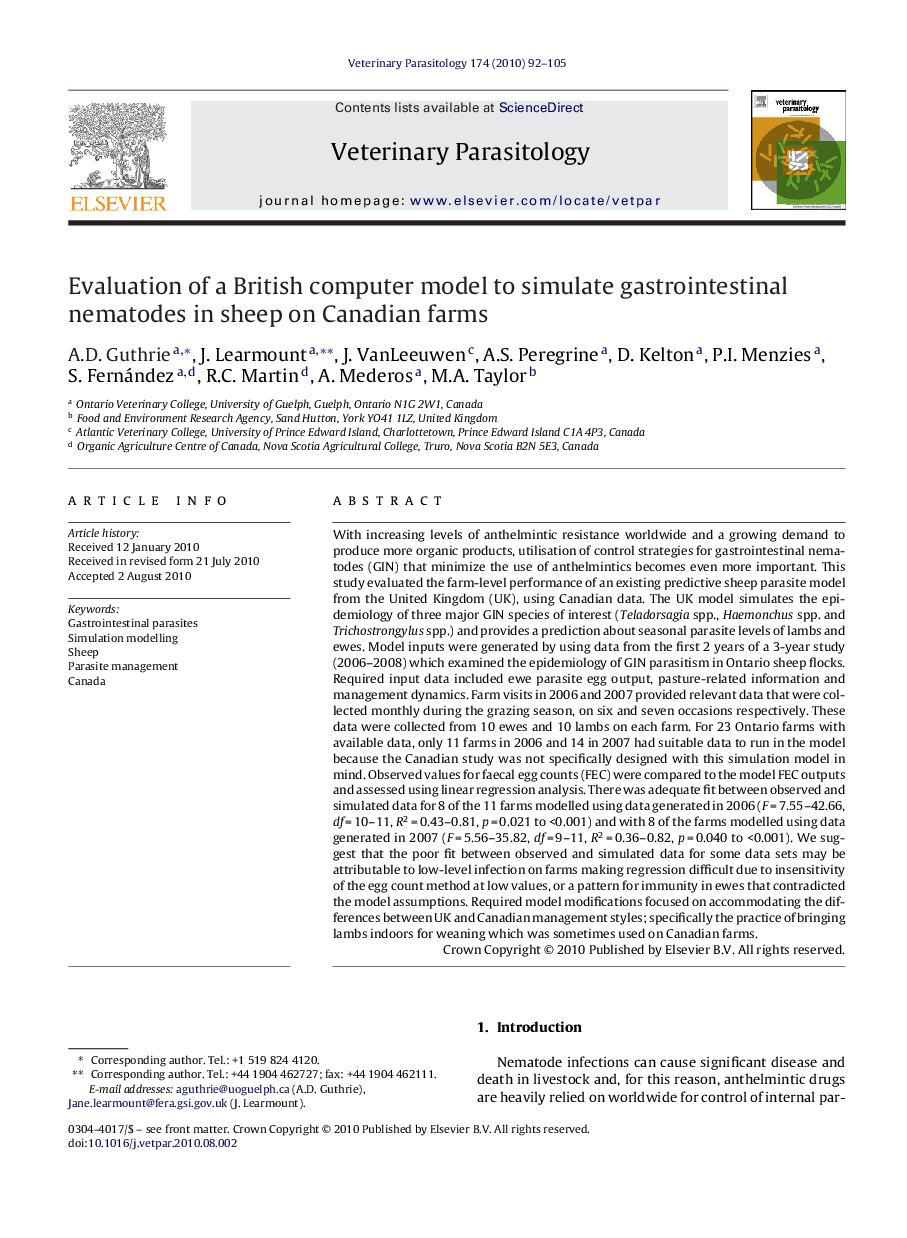| کد مقاله | کد نشریه | سال انتشار | مقاله انگلیسی | نسخه تمام متن |
|---|---|---|---|---|
| 2470513 | 1555733 | 2010 | 14 صفحه PDF | دانلود رایگان |
عنوان انگلیسی مقاله ISI
Evaluation of a British computer model to simulate gastrointestinal nematodes in sheep on Canadian farms
دانلود مقاله + سفارش ترجمه
دانلود مقاله ISI انگلیسی
رایگان برای ایرانیان
کلمات کلیدی
موضوعات مرتبط
علوم زیستی و بیوفناوری
علوم کشاورزی و بیولوژیک
علوم دامی و جانورشناسی
پیش نمایش صفحه اول مقاله

چکیده انگلیسی
With increasing levels of anthelmintic resistance worldwide and a growing demand to produce more organic products, utilisation of control strategies for gastrointestinal nematodes (GIN) that minimize the use of anthelmintics becomes even more important. This study evaluated the farm-level performance of an existing predictive sheep parasite model from the United Kingdom (UK), using Canadian data. The UK model simulates the epidemiology of three major GIN species of interest (Teladorsagia spp., Haemonchus spp. and Trichostrongylus spp.) and provides a prediction about seasonal parasite levels of lambs and ewes. Model inputs were generated by using data from the first 2 years of a 3-year study (2006-2008) which examined the epidemiology of GIN parasitism in Ontario sheep flocks. Required input data included ewe parasite egg output, pasture-related information and management dynamics. Farm visits in 2006 and 2007 provided relevant data that were collected monthly during the grazing season, on six and seven occasions respectively. These data were collected from 10 ewes and 10 lambs on each farm. For 23 Ontario farms with available data, only 11 farms in 2006 and 14 in 2007 had suitable data to run in the model because the Canadian study was not specifically designed with this simulation model in mind. Observed values for faecal egg counts (FEC) were compared to the model FEC outputs and assessed using linear regression analysis. There was adequate fit between observed and simulated data for 8 of the 11 farms modelled using data generated in 2006 (F = 7.55-42.66, df = 10-11, R2 = 0.43-0.81, p = 0.021 to <0.001) and with 8 of the farms modelled using data generated in 2007 (F = 5.56-35.82, df = 9-11, R2 = 0.36-0.82, p = 0.040 to <0.001). We suggest that the poor fit between observed and simulated data for some data sets may be attributable to low-level infection on farms making regression difficult due to insensitivity of the egg count method at low values, or a pattern for immunity in ewes that contradicted the model assumptions. Required model modifications focused on accommodating the differences between UK and Canadian management styles; specifically the practice of bringing lambs indoors for weaning which was sometimes used on Canadian farms.
ناشر
Database: Elsevier - ScienceDirect (ساینس دایرکت)
Journal: Veterinary Parasitology - Volume 174, Issues 1â2, 24 November 2010, Pages 92-105
Journal: Veterinary Parasitology - Volume 174, Issues 1â2, 24 November 2010, Pages 92-105
نویسندگان
A.D. Guthrie, J. Learmount, J. VanLeeuwen, A.S. Peregrine, D. Kelton, P.I. Menzies, S. Fernández, R.C. Martin, A. Mederos, M.A. Taylor,